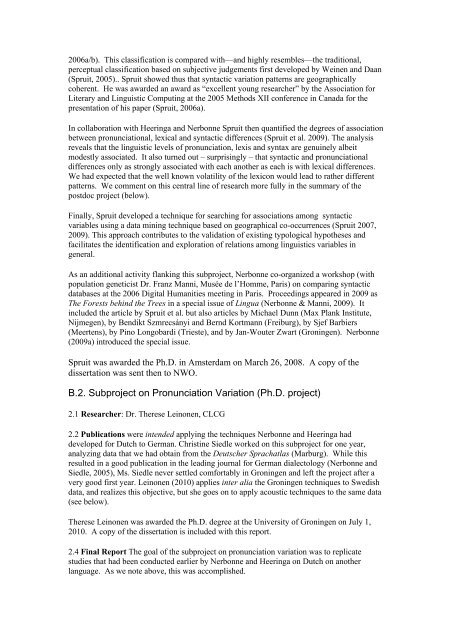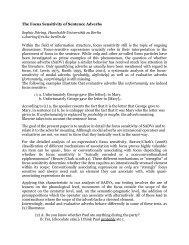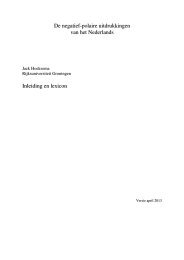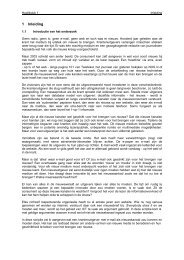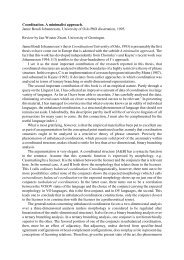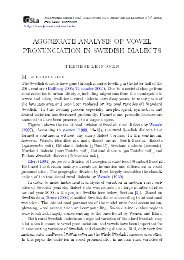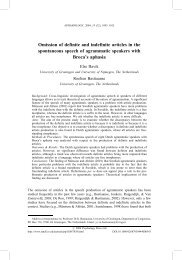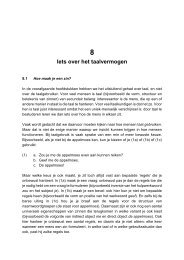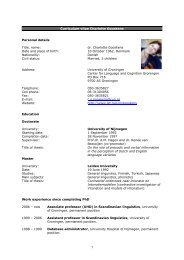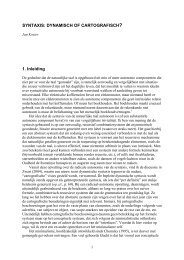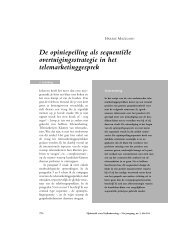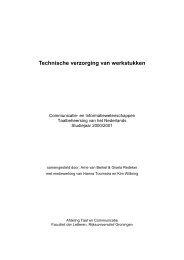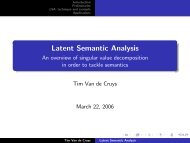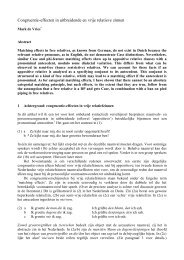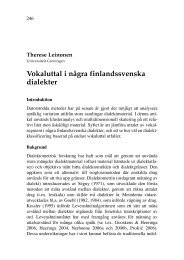Final Report Determinants of Dialect Variation
Final Report Determinants of Dialect Variation
Final Report Determinants of Dialect Variation
Create successful ePaper yourself
Turn your PDF publications into a flip-book with our unique Google optimized e-Paper software.
2006a/b). This classification is compared with—and highly resembles—the traditional,<br />
perceptual classification based on subjective judgements first developed by Weinen and Daan<br />
(Spruit, 2005).. Spruit showed thus that syntactic variation patterns are geographically<br />
coherent. He was awarded an award as “excellent young researcher” by the Association for<br />
Literary and Linguistic Computing at the 2005 Methods XII conference in Canada for the<br />
presentation <strong>of</strong> his paper (Spruit, 2006a).<br />
In collaboration with Heeringa and Nerbonne Spruit then quantified the degrees <strong>of</strong> association<br />
between pronunciational, lexical and syntactic differences (Spruit et al. 2009). The analysis<br />
reveals that the linguistic levels <strong>of</strong> pronunciation, lexis and syntax are genuinely albeit<br />
modestly associated. It also turned out – surprisingly – that syntactic and pronunciational<br />
differences only as strongly associated with each another as each is with lexical differences.<br />
We had expected that the well known volatility <strong>of</strong> the lexicon would lead to rather different<br />
patterns. We comment on this central line <strong>of</strong> research more fully in the summary <strong>of</strong> the<br />
postdoc project (below).<br />
<strong>Final</strong>ly, Spruit developed a technique for searching for associations among syntactic<br />
variables using a data mining technique based on geographical co-occurrences (Spruit 2007,<br />
2009). This approach contributes to the validation <strong>of</strong> existing typological hypotheses and<br />
facilitates the identification and exploration <strong>of</strong> relations among linguistics variables in<br />
general.<br />
As an additional activity flanking this subproject, Nerbonne co-organized a workshop (with<br />
population geneticist Dr. Franz Manni, Musée de l’Homme, Paris) on comparing syntactic<br />
databases at the 2006 Digital Humanities meeting in Paris. Proceedings appeared in 2009 as<br />
The Forests behind the Trees in a special issue <strong>of</strong> Lingua (Nerbonne & Manni, 2009). It<br />
included the article by Spruit et al. but also articles by Michael Dunn (Max Plank Institute,<br />
Nijmegen), by Bendikt Szmrecsányi and Bernd Kortmann (Freiburg), by Sjef Barbiers<br />
(Meertens), by Pino Longobardi (Trieste), and by Jan-Wouter Zwart (Groningen). Nerbonne<br />
(2009a) introduced the special issue.<br />
Spruit was awarded the Ph.D. in Amsterdam on March 26, 2008. A copy <strong>of</strong> the<br />
dissertation was sent then to NWO.<br />
B.2. Subproject on Pronunciation <strong>Variation</strong> (Ph.D. project)<br />
2.1 Researcher: Dr. Therese Leinonen, CLCG<br />
2.2 Publications were intended applying the techniques Nerbonne and Heeringa had<br />
developed for Dutch to German. Christine Siedle worked on this subproject for one year,<br />
analyzing data that we had obtain from the Deutscher Sprachatlas (Marburg). While this<br />
resulted in a good publication in the leading journal for German dialectology (Nerbonne and<br />
Siedle, 2005), Ms. Siedle never settled comfortably in Groningen and left the project after a<br />
very good first year. Leinonen (2010) applies inter alia the Groningen techniques to Swedish<br />
data, and realizes this objective, but she goes on to apply acoustic techniques to the same data<br />
(see below).<br />
Therese Leinonen was awarded the Ph.D. degree at the University <strong>of</strong> Groningen on July 1,<br />
2010. A copy <strong>of</strong> the dissertation is included with this report.<br />
2.4 <strong>Final</strong> <strong>Report</strong> The goal <strong>of</strong> the subproject on pronunciation variation was to replicate<br />
studies that had been conducted earlier by Nerbonne and Heeringa on Dutch on another<br />
language. As we note above, this was accomplished.


